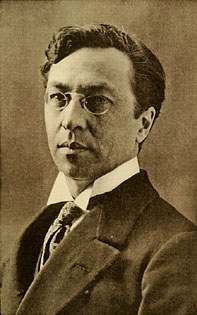Origine: Da Sguardo al passato, in Tutti gli scritti.
Vasilij Vasil'evič Kandinskij frasi celebri
Origine: Da Scritti intorno alla musica, a cura di Nilo Pucci, La Nuova Italia, 1979.
Origine: Da Dello spirituale nell'arte, in Tutti gli scritti, a cura di P. Sers, Feltrinelli, 1989.
1973
Punto, linea, superficie
1973
Punto, linea, superficie
1968
Punto, linea, superficie
1968
Punto, linea, superficie
“L'occhio aperto e l'orecchio vigile trasformano le più piccole scosse in grandi esperienze.”
1968
Punto, linea, superficie
Vasilij Vasil'evič Kandinskij: Frasi in inglese
Quote from: 'Analysis of the Primary Elements of Painting', W. Kandinsky, 1928
1920 - 1930
Origine: 1916 -1920, Autobiography', 1918, p. 34
Kandinsky is remembering his experience that he saw one of the 'Haystack' paintings of Monet, for the first time in his life, in Moscow (1895)
Origine: 1916 -1920, Autobiography', 1918, p. 10
Quote of Kandinsky, 1911; in Concerning the Spiritual in Art, transl. Michael T. Sadler (1914); reprint. New York: Dover, 1977), p. 17
1910 - 1915
Quote from Concerning the Spiritual in Art, Wassily Kandinsky, Munich, 1912; as cited in Kandinsky, Frank Whitford, Paul Hamlyn Ltd, London 1967, p. 15
1910 - 1915
Origine: 1916 -1920, Autobiography', 1918, p. 33
1910 - 1915, On the Problem of Form (1912)
Origine: 1916 -1920, Autobiography', 1918, p. 9
Quote of Kandinsky, from Bauhaus - Zeitschrift für Gestaltung, no. 3, 1931; as cited in 'Klee & Kandinsky', 2015 exhibition text, Lenbachhaus und Kunstbau Munich, 2015-2016 https://www.zpk.org/en/exhibitions/review_0/2015/klee-kandinsky-969.html
1930 - 1944
as quoted in Wassily Kandinsky: Life and Work, Will Grohmann. H. N. Abrams, 1958 p. 78
1920 - 1930
Quote, c. 1910; as cited by de:Wolf-Dieter Dube, in Expressionism; Praeger Publishers, New York, 1973, p. 112
1910 - 1915
Origine: 1916 -1920, Autobiography', 1918, p. 9
“Opposites and contradictions, that is our harmony.”
German original: Gegensätze und Widerspruche, dass ist unsere Harmonie.
short quote, 1911; as cited in schönberg and Kandinsky: An Historic Encounter, by Klaus Kropfinger; ed. Konrad Boehmer; published by Routledge (imprint of Taylor & Francis, an informal company), 2003, p. 9, note 1
1910 - 1915
in his letter to Arnold Schönberg, 18 Jan. 1911; as cited in Schonberg and Kandinsky: An Historic Encounter, by Klaus Kropfinger; edited by Konrad Boehmer; published by Routledge (imprint of Taylor & Francis, an informal company), 2003, p. 9
Kandinsky visited a concert with music of Schönberg on 11 Jan. 1911 with Franz Marc, Alexej von Jawlensky, Gabriele Münter and others; they played compositions, Schönberg wrote in 1907 and 1909: his second string quartet and the 'Three piano pieces'
1910 - 1915
Quote from: On the Spiritual in Art, 1911; as cited in Schönberg and Kandinsky: An Historic Encounter, by Klaus Kropfinger; edited by Konrad Boehmer; published by Routledge (imprint of Taylor & Francis, an informal company), 2003, p. 17
1910 - 1915
1920 - 1930, Point and line to plane, 1926
Quote of Kandinsky, in Paris, March 1935; as cited in Artists on Art – from the 14th – 20th centuries, ed. by Robert Goldwater and Marco Treves; Pantheon Books, 1972, London, p. 451
1930 - 1944
Origine: 1916 -1920, Autobiography', 1918, p. 16
I. Kandinsky's introduction: Lead paragraph
1910 - 1915, Concerning the Spiritual in Art, 1911
“[Art is].. the mysterious expression of the mysterious..”
Origine: 1916 -1920, Autobiography', 1918, p. 17
of Die Brücke paintings in The Blaue Reiter Almanac
Quote from his letter to Franz Marc, 2 Febr. 1912, as cited in 'Lankheit 20'; quoted in Movement, Manifesto, Melee: The Modernist Group, 1910-1914, Milton A. Cohen, Lexington Books, Sep 14, 2004, p. 71
1910 - 1915
'..stripes and spots with the knife', as he learned then also Gabriele Münter - they frequently painted together in open air
Origine: 1916 -1920, Autobiography', 1918, p. 31
Quote from Kandinsky's letter to Gabriele Münter, June 1916; as cited in lrike Becks-Malorny, Wassily Kandinsky, 1866–1944: The Journey to Abstraction [Cologne: Taschen, 1999], pp. 115, 118
Kandinsky left Münter and Murnau in 1914, because the first World War started and Kandinsky had a Russian nationality
1916 -1920
Quote of Kandinsky, Munich, 1910; as cited in Artists on Art – from the 14th – 20th centuries, ed. by Robert Goldwater and Marco Treves; Pantheon Books, 1972, London, p. 450
1910 - 1915
Quote of Kandinsky, in the introduction of an exhibition-catalog 'Neue Künstlervereinigung', 1913, Munich; as cited by , in Expressionism; Praeger Publishers, New York, 1973, p. 119-120
1910 - 1915
“An empty canvas is a living wonder - far lovelier than certain pictures.”
Quoted in: Myfanwy Evans Piper (1937) The Painter's Object. p. 53
1930 - 1944
as quoted by de:Wolf-Dieter Dube, in Expressionism; Praeger Publishers, New York, 1973, p. 109
undated quotes
Quote of Kandinsky, from the catalog of the second exhibition of the 'Neue Künstlervereinigung', München, August, 1910; as cited by de:Wolf-Dieter Dube, in Expressionism; Praeger Publishers, New York, 1973, p. 95
1910 - 1915
From an interview, 28 July 1935, in the Italian daily newspaper 'Lavoro fascista'; as quoted in Kandinsky in Paris: 1934-1944 - exhibition catalog, published by The Solomon K. Guggenheim Foundation, New York, 1985, p. 30
1930 - 1944
